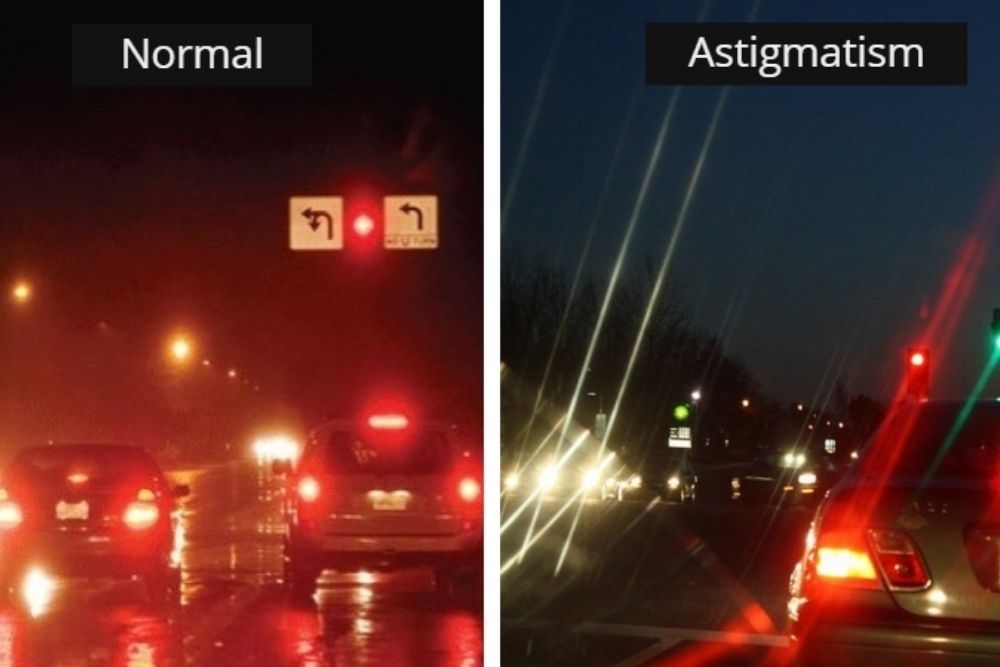Astigmatism is not a disease. It is only a type of vision condition or a refractive error. It causes blurry and distorted vision which commonly occurs in the global population.
The normal human eye contains only one curve with an egg-shaped surface and astigmatism occurs when the cornea has mismatched curves. Astigmatism usually begins at birth and may be followed by nearsightedness or farsightedness. Generally, it is treated with corrective lenses or surgery.

Astigmatism Explained
The surface of your eye is called the cornea. It is a transparent dome that is curved like the lenses on a telescope. A correctly curved cornea and accurately focuses light on the retina to produce clear vision as it reaches the brain. Perversely, corneas and lenses in the eye may have mismatching curves that distort the vision, which we call astigmatism.
One of the most prevailing refractive errors is astigmatism. It is commonly accompanied by myopia (nearsightedness) and hyperopia (farsightedness. These accompanying conditions determine the category of astigmatism a patient may have, such as myopic, hyperopic, or mixed astigmatism.
Causes
Astigmatism is mainly caused by an imperfection in the anatomy of the eye. In a deeper explanation, the anatomy of the eyes consists of two curved surfaces that are responsible for bending light onto the retina. This is called refraction. These two curved surfaces are:
- Cornea – the transparent surface in front of the eye
- Lens – an internal transparent structure that changes shape for a better focus on near objects
In an eye without astigmatism, both the cornea and lens have perfectly round and smooth curvature and surface. With correctly structured cornea and lens, the light is equally refracted to make a sharp image directly on the retina.
Symptoms
Common signs of astigmatism are:
- Blurry and distorted vision
- Discomfort in the eyes
- Eyestrain
- Frequent squinting
- Headaches
- Poor night vision

Diagnosis
Ophthalmologists examine the cornea for structure imperfections. They use lines called meridians to section the arc of the cornea. Meridians function like the north-to-south and east-to-west meridians on a map.
When evaluating astigmatism, doctors observe meridians like the hands on a clock. For instance, one meridian connects the 6 (bottom) to the 12 (top) and another meridian goes from 9 (left) to 3 (right).
A perfect cornea has a consistent arc. However, with astigmatism, the arc may be too steep or too flat in one meridian to the other. Determining principal meridians which are the steepest and flattest parts of the cornea is crucial in diagnosing how astigmatism distorts the vision. These findings will help categorize astigmatism.
Categories of Astigmatism
- Myopic astigmatism. Myopia is defined as nearsightedness. Myopic astigmatism occurs when the principal meridians generate nearsightedness + astigmatism.
- Hyperopic astigmatism. Hyperopia is defined as farsightedness. Therefore, hyperopic astigmatism produces farsightedness + astigmatism.
- Mixed astigmatism. When one principal meridian of the cornea produces nearsightedness and the other farsightedness, eye doctors refer to this as mixed astigmatism.
Common Types of Astigmatism
- Regular astigmatism. This occurs when the principal meridians are 90 degrees apart or appear to be perpendicular to each other.
- Irregular astigmatism. Principal meridians that are not perpendicular to each other are deemed irregular. Keratoconus, scarring, and injuries may be some of the possible causes of irregular astigmatism.
- Corneal and lenticular astigmatism. The most common type of astigmatism occurs in the cornea. Hence, this is called corneal astigmatism. In rare cases, astigmatism takes place in the intraocular lens as opposed to in the cornea. This is then called lenticular astigmatism.

Treatment Options for Astigmatism
Eyeglasses. Corrective lenses may restore a 20/20 vision to people with regular astigmatism. Although, severe or irregular astigmatism can no longer be restored to 20/20 vision by prescription lenses.
Contact lenses. There are three primary varieties in special contact lenses that correct astigmatism.
- Toric. These are soft contact lenses that have different levels of refraction that align with meridians of the eye. This enables precise vision.
- Gas permeable. Compared to toric lenses, these are rigid lenses that have a uniform shape. These replace the refraction effect of the cornea which provides clearer vision compared to toric lenses. Because of the rigid structure, gas permeable lenses may be less comfortable.
- Hybrid. This is a combination of toric and gas permeable lenses. It is designed with a rigid center for superb visual clarity but has soft edges to provide more comfort. Hybrid and gas permeable lenses are harder to achieve precise fitting but can provide better results.
Surgery. For severe cases, the best options could be to surgically reshape the cornea and remove cataracts. LASIK surgery may be one of the great choices. This procedure uses high-precision lasers to make the cornea more symmetrical. This can correct moderate degree astigmatism permanently.
Furthermore, a toric intraocular lens (IOL) may also be implanted in the eye to correct astigmatism and remove cataracts at the same time. Before opting for surgery, weigh all the pros and cons of each treatment option. Note that surgery is permanent and can be irreversible, so consider all the risks before undergoing the procedure.
Astigmatism may vary in each and every one. Not one size fits all. Therefore, what could be the best treatment for one person does not mean it is the best for everybody. Pay extra attention to details especially before undergoing surgery.
Make proper research and consult your doctor before your final decision.
Your eye doctor will help you review all available options for better, clearer, more comfortable, and efficient vision.



